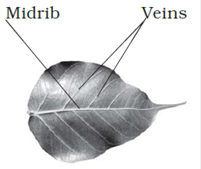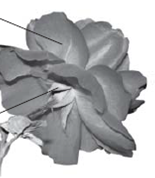Getting To Know Plants - Solutions
CBSE Class–VI Subject Science
NCERT Solutions
(CHAPTER-07)
Getting to Know Plants
Question 1. Correct the following statements and rewrite them in your notebook.
(a) Stem absorbs water and minerals from the soil.
(b) Leaves hold the plant upright.
(c) Roots conduct water to the leaves
(d) The number of petals and sepals in a flower is always equal.
(e) If the sepals of a flower are joined together, its petals are also joined together, its petals are also joined togather.
(f) If the petals of a flower are joined together, then the pistil is joined to the petals.
Answer: The correct statements are
(a) Roots absorb water and minerals from the soil.
(b) Stem holds the plant upright.
(c) Stem conducts water to the leaves.
(d) The number of petals and sepals in a flower is usually the same.
(e) If the sepals of flower are joined together, its petals are not necessarily joined together.
(f) If the petals of a flower are joined together, then the pistil is not necessarily joined to the petals.
Question 2. Draw (a) Leaf (b) A taproot (c) A flower, you have studied for Table 7.3.
Answer: Leaf

Tap root

Flower

Question 3. Can you find a plant in your house or in your neighborhood, which has a long but a weak stem? Write its name. In which category would you classify it?
Answer: Yes, Lauki (guard) plant. It needs support. It comes under the category of climber plant.
Question 4. What is the function of a stem in a plant?
Answer: Function of stem:
(i) Gives support to plant.
(ii) Conducts water and minerals from roots to leaves.
(iii) Conducts food from leaves to other parts of the plant.
Question 5. Which of the following leaves have reticulate venation?
Wheat,Tulsi, Maize, Grass,Coriander(dhania), China rose.
Answer: Tulsi, Coriander(dhania) and China rose have reticulate venation.
Question 6. If a plant has fibrous root, what types of veneration do its leaves likely to have?
Answer: Parallel venation.
Question 7. If a plant has leaves with reticulate venation, the kind of roots will it have?
Answer: Tap root,
Question 8. Is it possible for you to recognize the leaves without seeing them? How ?
Answer: Yes, by taking an impression of the leaf. Put paper on the leaf. Hold the pencil tip sideways and rub it on the portion of paper having leaf below. You get impression of leaf with some lines on it. These lines help us to recognize the types of leaf.
Question 9. Write the name of the parts of flower.
Answer: Parts of flower:
(i)Sepals ( Calyx), (ii)Petals (Corolla) , (iii)Stigma, (iv)Style, (v)Anther, (vi) Stamens
(Androeciumm), (vii)Pistil (Gynoecium)
Question10. Which of the following plants have you seen? Of those that you have seen, which one have flowers?
Grass, Maize, Wheat, Chili, Tomato, Tusli, Pipal, Shisham, Banana, Mango, Jamun, Guava, Pomegranate, Papaya, Banana, Lemon, sugarcane, Potato, Groundnut.
Answer: I have seen all these plants. Plants with flower are
Maize, Chili, Tomato, Tulsi, Shishma, Mango, Lemon, Jamun, Guava, Pomegranate, Papaya, Banana, and Lemon.
Question 11. Name the part of the plant which produces its food. Name this process.
Answer: Leaves of green plants produce food. The process is called photosynthesis.
Question 12. In which part of flower you likely to find the ovary?
Answer: It is the lowermost and swollen part of the pistil.
Question 13. Name two flowers, each with joined and separated sepals.
Answer: Joined sepals- Rose, Lotus
Separate sepals- China rose, mustard flower.
